Today at its MAX conference Adobe announced the immediate availability of updates to Lightroom CC (mobile) for iOS and Android, and to Lightroom CC Web. Lightroom mobile and web are now being positioned as fully integrated components of the “Lightroom CC Ecosystem”, consisting of the new cloud-based Lightroom CC desktop application, Lightroom CC iOS, Lightroom CC Android, and Lightroom CC Web (at lightroom.adobe.com):
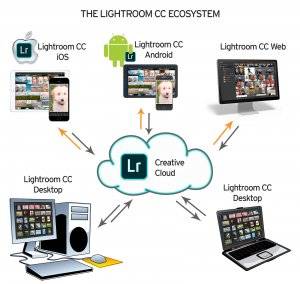
With Lightroom CC, you’ll automatically have all your photos with you everywhere you go and the work you do on them will seamlessly show up everywhere else.
There is and will be only limited integration between Lightroom CC iOS and Android with Lightroom Classic, which is the new name for the Lightroom program we have been using for years and that is now on version 7. Current functionality that syncs smart previews and editing from Lightroom Classic to iOS and Android, and full size files and editing from iOS, Android and Web to Lightroom Classic desktop will remain – but that’s it for Adobe’s investment in syncing to and from Lightroom Classic – as Adobe adds new features to the Lightroom CC ecosystem, they will not sync to Lightroom Classic. Adobe frames their decision as one of supporting Lightroom Classic as a desktop-centric solution, and Lightroom CC as a cloud-centric solution. You’ll see the implications of this illustrated below with keywords and folders.
What’s New in Lightroom CC iOS Version 3.0
The iOS Lightroom mobile application we have been using for quite some time on iPads and iPhones will now be known as Lightroom CC iOS. Adobe released version 3.0 today. In addition to miscellaneous design tweaks, navigation improvements and bug fixes, the following have been added:
Add keywords to photos. Lightroom Classic users have been wanting to be able to keyword from our mobile device users since Lightoom mobile was first introduced. However, keywords entered on mobile will only sync to the new cloud-based Lightroom CC; they will NOT sync to Lightroom Classic. I’m sure I won’t be the only one unhappy about this.
In single-photo view, click on the dropdown, choose Keywords, and type in keywords separated by commas.
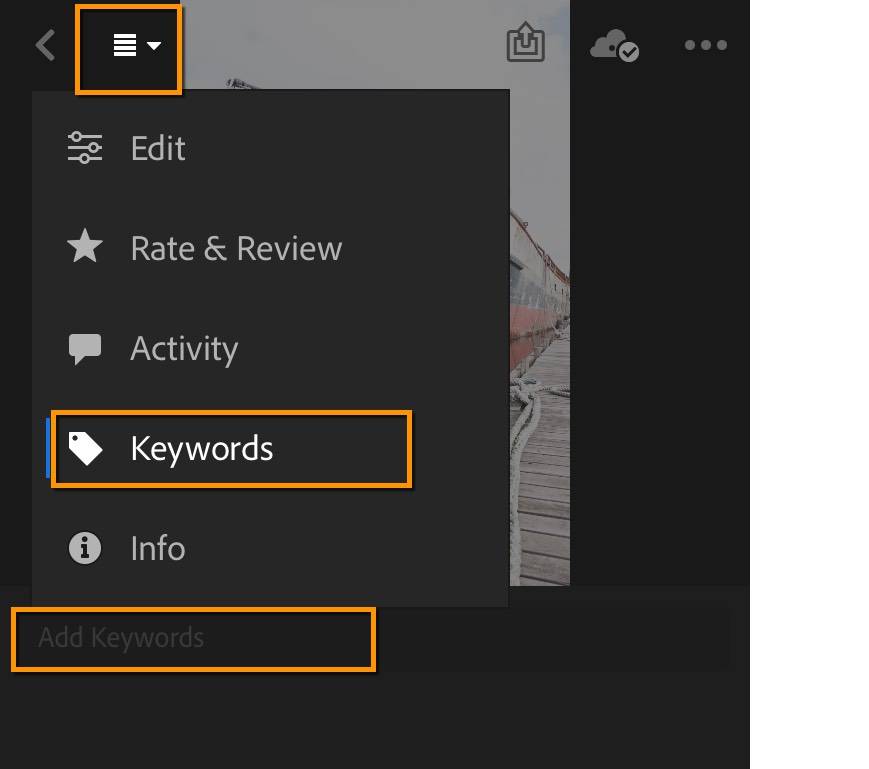
Note that Lightroom CC (desktop and mobile) keywords are flat – hierarchies are not supported.
Right now you can only keyword in single-photo view, but you can copy keywords from one photo to another. Tap on the ••• in the top right and choose Copy Keywords (and Paste Keywords)
Create folders and subfolders to store your albums in. (Collections will now be known as “albums” throughout the Lightroom CC ecosystem – i.e. everywhere except in Lightroom Classic.) Folders are like album sets – they are used to organize your albums. They are not folders in the sense of folders on your hard drive. Folders will sync to and from Lightroom CC Desktop, but not to/from Lightroom Classic.
In Albums view, tap on the + to the right of “Albums”, and choose Create Folder. To move an album into it, tap on the three dots to the right of the album, choose Move To, and then the folder.
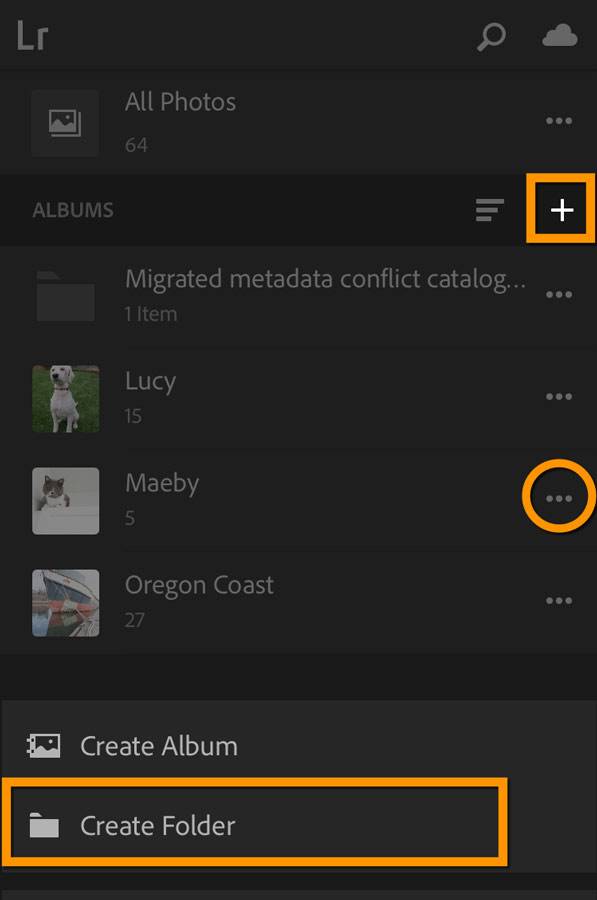
Focus peaking: in manual focus the camera live preview will show in green what’s in focus.
Pause and resume sync in the Cloud panel. (Use it while traveling, to avoid expensive hotspot charges, limited wifi, etc.)
Change in Sync settings: to save device storage space, downloading smart previews is now the default – change by turning off in LR>Cloud Storage & Sync.
A blue floating action button has been added to provide easier access to the camera and to Add Photos.
Import from and export to iOS Files (iOS 11).
Jump to the top in Organize and in All Photos by tapping on free space in the top bar.
Sort by Import Date has been added to grid view – access it through the ••• menu.
Edit sliders: make more granular (smaller) adjustments by tapping and holding on a slider, then sliding your finger up and then side to side.
LR Settings lists GB of free space rather than %.
Selective edits: long tap on an adjustment pin (symbol) brings up options to duplicate or remove brush, show/hide overlay.
Add Photos in album ••• includes iOS “Files”
Add Photos available in Organize view.
Delete photos from within albums (not just remove from album)
Rejected photos are dimmed
Search available in Album and Folder view
All Photos no longer segmented by default. Use the ••• menu > Grid View > Segmented.
iPad Only:
Drag and drop support (iOS 11 only)
Reduced size of side panel
Presets, Crop, Selective moved to the right bar
What’s New in Lightroom CC Android 3.1
Add keywords to photos. Will not sync to Lightroom Classic – see note above under iOS keywords. Keywords are added on the Info panel.
Folders – store your albums in up to 5 levels of nested folders. These will not sync to Lightroom Classic (see note above under iOS folders).
Search! This feature, now available throughout the Lightroom CC ecosystem, uses Adobe’s “Sensei” machine learning and artificial intelligence technology to analyze the content of your images. A search for “dogs” will bring back images with dogs in them regardless of whether you have keyworded these photos. It’s impressive but far from perfect – you’ll get false positives (photos that don’t have dogs in them) and false negatives (it may miss photos in your library that have dogs in them.) This feature requires an internet connection.
Brush for making local adjustments (premium feature, available to CC subscribers only)
Add photos to albums from All Photos.
All new design for tablet and Chromebook
Export copy of your original (with no edits)
Process version updated to PV 4 (consistent with Lightroom Classic 7.)
What’s New in Lightroom CC Web
Folders – store your albums in up to 5 levels of nested folders. These will not sync to Lightroom Classic (see note above under iOS folders). Create a folder by clicking on the + to the right of ALBUMS, name it, then drag your album(s) into the newly created folder.
Search has graduated from a Technology Preview to a fully-available feature, now available throughout the Lightroom CC ecosystem. See my explanation above in the Android section.
Best Photos. This new automated-curation feature is available as a technology preview. To turn it on, click on the LR icon in the top left of your browser > Technology Preview > Best Photos). Then select an Album and you’ll see a Best Photos icon above the grid:

Best Photos will first score your images based on image aesthetics and image content. It then clusters the the images by time and similarity to eliminate images that are too similar, and finally produces its set of “best photos”. You can change the score threshold with the Fewer/More slider. Images that don’t fall in Best Photos are put in Other Photos. You can create and share an album of the best. Finally, close the feature by clicking on the X in the top right.

Galleries: add multiple albums to a gallery so you can share a single gallery URL.
Click on the globe icon below the Photos (box) icon on the left edge of your browser:
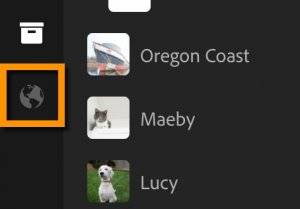
Add albums and customize the name and metadata to be shared. Copy the URL and send it to whoever you want to have view your gallery.
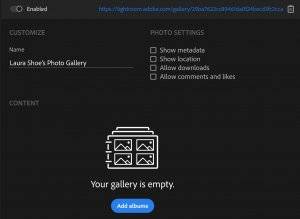
Storage usage and upload status are available under the cloud menu.
The web interface is now more consistent with Lightroom CC on mobile and desktop.
Related Content
There are many more Lightroom-related announcements today – visit my Lightroom Classic and Lightroom CC resource page for articles and video tutorials covering all of this week’s Lightroom news and releases !


Thank you Laura for your detailed, and easy to understand explanation . As a photography enthusiast, and current L.R. creative cloud subscriber, I can see many benefits of changing to the new cloud based Lightroom CC system. I have found myself using the mobile iPad app more and more in recent months and have enjoyed the surprising ease of doing many editing tasks. That being said, I’m still sad to see the separation between the desktop classic version and the cloud based L.R. CC. I have invested so much time in learning the program with your videos, and organizing my catalog. I feel like I would be “ throwing the baby out with the bath water,” if I choose L.R.CC at this point in time, since so much functionality is missing and I don’t understand how the search function would work . I would like to hear your thoughts on this (and hopefully some ideas for best practices) for those of us who want to try the CC version, but want to keep some of our photos permanently on our desktops and not shared in the cloud at all